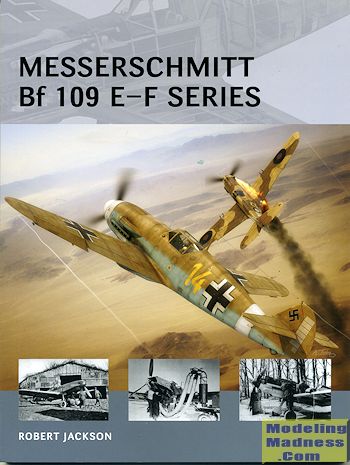 One of
the iconic fighter planes of WWII was the Luftwaffe's Bf-109 series. It was the
early versions powered by the DB601 engine, the Bf-109E and Bf-109F that were
operational during the the early years of the war and the planes that the Allies
met over the battlefield, whether it be the front lines of Africa, Russia or
Western Europe. These were the planes that also met the initial bombing raids of
the RAF and the USAAF.
One of
the iconic fighter planes of WWII was the Luftwaffe's Bf-109 series. It was the
early versions powered by the DB601 engine, the Bf-109E and Bf-109F that were
operational during the the early years of the war and the planes that the Allies
met over the battlefield, whether it be the front lines of Africa, Russia or
Western Europe. These were the planes that also met the initial bombing raids of
the RAF and the USAAF.
The 109 was the Luftwaffe's initial fighter of choice because it was
easy to build, fast, and armed well enough to down enemy planes. It was not the
most maneuverable aircraft around, having rather high stick forces at high
speed, but despite its lack of maneuverability against the opposition, it was
able to generally come out ahead in air combat. This was due as much to pilot
skill and training as anything else.
This edition of Air Vanguard is a bit different than some of the others
in that it is basically a diary of operations of the two types, starting with
the beginning of the war and the 109E, going through Norway, Belgium,
Netherlands and France, where the opposition was generally of types that were
inferior to the 109E. It wasn't until the Battle of Britain that the Spitfire
was encountered in any numbers as the RAF did not send any to France, relying on
the still capable, but slower Hurricane as the RAF's contingent. It was the
Battle that showed the 109s main weakness, and that was a lack of range. While
drop tanks were developed, they were generally too late for the majority of
engagements.
In 1941 the improved 109F started entering service and it was a more
potent aircraft, seeing much of its action in Russia and North Africa. The E
model was still being used in these theaters as well as in the Balkans, but its
use outside of fighter bomber units was on the wane. Foreign use of the 109E is
also covered in this volume as Axis partners flew both it and later the F,
mostly on the Eastern Front. With the introduction of the G and its great weight
as well as more powerful engine in 1942, the F was soon relegated to second line
duties as well.
The author has done a fine job of telling the story of these two planes
and the inclusion of some fine period photos and some nice artwork really adds
to this volume. The author also made some interesting comments outside the
realms of this book when he went on to tell a bit more about later 109 versions
and stated that both the 109K-6 and 109K-14 saw action in the later days of the
war. This raised my eyebrows as I had read in many sources that the K-6 never
saw operational use and the K-14 never got beyond the drawing board. The author
also states that the apparently never-photographed Bf-109H was built in small
numbers and saw operational service in high altitude recon.
In all, it is a very nicely done book that reads well. It is a
book that I enjoyed reading and one that I can easily recommend to you.
September 2015
For more on the complete line of Osprey books,
visit http://ospreygrp.com. In the US, it is
Osprey Direct at 44-02 23rd St, Suite 219, Long Island City, NY 11101., where you can
get a catalogue of available books.
If you would like your product reviewed fairly and
fairly quickly, please
contact
the editor or see other details in the
Note to
Contributors.
 One of
the iconic fighter planes of WWII was the Luftwaffe's Bf-109 series. It was the
early versions powered by the DB601 engine, the Bf-109E and Bf-109F that were
operational during the the early years of the war and the planes that the Allies
met over the battlefield, whether it be the front lines of Africa, Russia or
Western Europe. These were the planes that also met the initial bombing raids of
the RAF and the USAAF.
One of
the iconic fighter planes of WWII was the Luftwaffe's Bf-109 series. It was the
early versions powered by the DB601 engine, the Bf-109E and Bf-109F that were
operational during the the early years of the war and the planes that the Allies
met over the battlefield, whether it be the front lines of Africa, Russia or
Western Europe. These were the planes that also met the initial bombing raids of
the RAF and the USAAF.